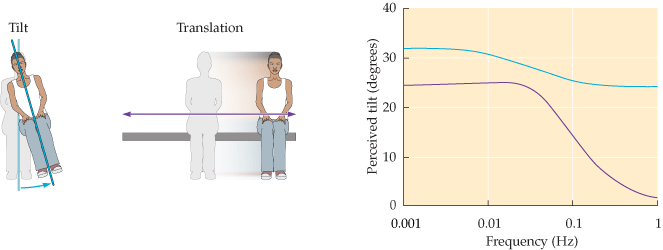Essay 12.2 Canal–Otolith Integration
When humans are passively roll-tilted in the dark with the center of the head located near the tilt axis (left side of figure below, labeled “Tilt”), the otolith organs record variations in the gravitational force relative to the head while the semicircular canals simultaneously measure the angular velocity of the head. In fact, when such roll tilts are sinusoidal at physiological frequencies (around 0.5 Hz), normal humans more or less accurately indicate how much they move, even in the dark (see figure below). This finding should not be too surprising, since the otolith organs accurately record head orientation with respect to gravity. In fact, one might even incorrectly conclude that the otolith signal alone explains this perception.

Data show the magnitude of roll tilt perception between 0.005 and 0.7 Hz. The otolith cues can be made nearly identical for the tilt and translation conditions, but the semicircular canal cues are very different, since the tilt condition includes a roll rotation while the translation condition does not. At low frequencies, in which the canals are relatively insensitive, there is little or no difference in the measured tilt perception. However, at higher frequencies—those in the physiological range of motion (around 0.5 Hz)—there is a substantial difference between the tilt perceived when the subject is actually tilted and when the subject is merely translated. This difference reflects the contributions of the semicircular canals, which accurately sense roll rotation during roll tilt stimulation and accurately sense the absence of rotation during translation stimulation at these frequencies. (After Merfeld et al., 2005; Park et al., 2006.)
Before settling on this conclusion, however, consider what happens when nearly identical otolith cues are provided by side-to-side sinusoidal translation of the same subjects. Interestingly, even though the otolith signals are nearly identical, the subjects no longer indicate much (if any) perceived tilt. The primary difference in the motion stimuli is that in the first test condition (roll tilt), the canals provide a signal indicating that the subject is rotating in roll, which would yield a roll tilt, while in the second test condition (translation), the canals provide a signal indicating that the subject is not rotating in roll. Specifically, although the otolith organs are the primary sensors of gravity and, hence, of head tilt with respect to gravity, signals from the semicircular canals also contribute in a fundamental manner to tilt perception.
If the otolith organs sense gravity, why is other sensory information needed for tilt perception? Recall that the signals being sent to the brain from the otolith organs are ambiguous; the firing rate may reflect change because orientation with respect to gravity has changed or because linear velocity has changed (that is, a linear acceleration has occurred). The semicircular canals provide additional information that can often help resolve the ambiguity. For example, consider when you nod your head to indicate “yes.” The orientation of gravity relative to your head changes while you nod and this change is registered by the otolith organs. Simultaneously, the semicircular canals measure head rotation. Therefore, the semicircular canals tell the brain that the head is rotating and that it should, therefore, expect changes in head orientation with respect to gravity, which it then confirms with measurements from the otolith organs.
References
Merfeld, D. M., Park, S., Gianna-Poulin, C., Black, F. O., and Wood, S. (2005). Vestibular perception and action employ qualitatively different mechanisms. I. Frequency response of VOR and perceptual responses during translation and tilt. Journal of Neurophysiology 94: 186–198.
Park, S., Gianna-Poulin, C., Black, F. O., Wood, S., and Merfeld, D. M. (2006). Roll rotation cues influence roll tilt perception assayed using a somatosensory technique. Journal of Neurophysiology 96: 486–491.